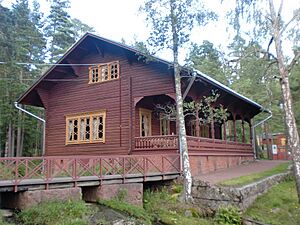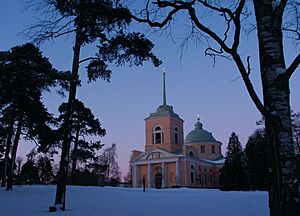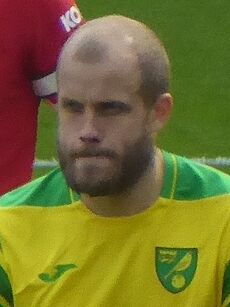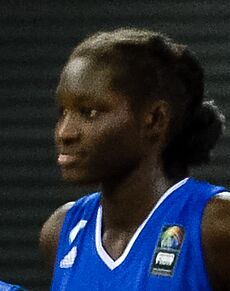Kotka facts for kids
Quick facts for kids
Kotka
|
||
|---|---|---|
|
City
|
||
| Kotkan kaupunki Kotka stad City of Kotka |
||

Kotka in July 2019
|
||
|
||
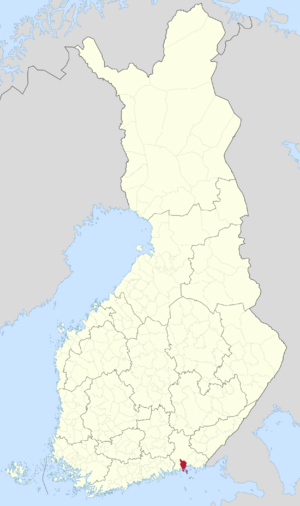
Location of Kotka in Finland
|
||
| Country | ||
| Region | ||
| Sub-region | Kotka-Hamina sub-region | |
| Charter | 16 July 1879 | |
| Area
(2018-01-01)
|
||
| • Total | 949.77 km2 (366.71 sq mi) | |
| • Land | 272.13 km2 (105.07 sq mi) | |
| • Water | 678.45 km2 (261.95 sq mi) | |
| Area rank | 239th largest in Finland | |
| Population
(2023-12-31)
|
||
| • Total | 50,500 | |
| • Rank | 21st largest in Finland | |
| • Density | 185.57/km2 (480.6/sq mi) | |
| Population by native language | ||
| • Finnish | 88.5% (official) | |
| • Swedish | 1% | |
| • Others | 10.6% | |
| Population by age | ||
| • 0 to 14 | 13.1% | |
| • 15 to 64 | 59.2% | |
| • 65 or older | 27.7% | |
| Time zone | UTC+02:00 (EET) | |
| • Summer (DST) | UTC+03:00 (EEST) | |
| Postal code |
48400
|
|
| Climate | Dfb | |
Kotka (Finnish pronunciation: [ˈkotkɑ]; lit. "eagle") is a town in Finland, located on the southeastern coast of the country at the mouth of the Kymi River. The population of Kotka is approximately 51,000, while the sub-region has a population of approximately 80,000. It is the 21st most populous municipality in Finland, and the 16th most populous urban area in the country.
Kotka is situated in the southern part of the Kymenlaakso province of Finland. Kotka is a major port and industrial city situated on the coast of the Gulf of Finland. Kotka is a culturally diverse city with a variety of schools. It was previously a part of the former Kymi parish. Kymi, Haapasaari island, and Karhula, which was once a separate market town, were later incorporated into Kotka. Kotka's neighboring municipalities are Hamina, Kouvola, and Pyhtää. The neighboring municipalities of Kotka are Hamina, Kouvola, and Pyhtää. Kotka is situated in the Kotka-Hamina subdivision and, along with Kouvola, is one of the main centres of the Kymenlaakso region.
The city centre of Kotka is located on an island in the sea called Kotkansaari ("Island of Kotka"). The main road in Kotka is the Finnish national road 7 (E18), which runs west through Porvoo to Helsinki, the capital of Finland, and extends east to St. Petersburg, Russia. The Port of Kotka is a major Finnish seaport serving both Finnish and Russian foreign trade. The municipality is officially unilingually Finnish, with 88% being native Finnish speakers, 1% Swedish, and 10% speaking some other language.
Contents
Heraldry
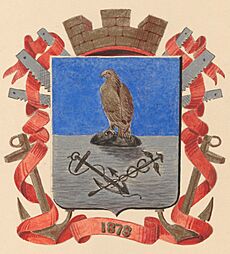
The description of the older coat of arms read that "the upper field of the split shield is blue, the lower field silver, and in the center of the shield a natural stone with a golden eagle, and in the lower field the anchor and caduceus diagonally crossed, both blue," while the current coat of arms is described as follows: "In a blue field, the wings of a golden natural eagle are raised, standing with a crossed anchor and caduceus, both of which are silver." The first coat of arms of the city of Kotka was confirmed in 1881. However, the Kotka City Council had to renew the old coat of arms in 1954 because it did not meet heraldic requirements. The new coat of arms was designed by Olof Eriksson in 1957, Eriksson kept the new coat of arms as the main emblem of Kotka referring to the name of the city. From the images of the current coat of arms, the anchor reflects the importance of Kotka as a port town and caduceus in trade, industry and maritime traffic.
History
On 16 April 1878, the Senate of the Grand Duchy of Finland issued a declaration establishing a city on the southern part islands from the old Kymi parish, so in 1879 the islands of Kotkansaari and Hovinsaari were separated from Kymi and the city of Kotka was established.
The Second All-Russian Conference of the Russian Social Democratic Labour Party was held in Kotka, on 21–23 July (3–5 August) 1907.
Historically, Swedish was the official language in the city until 1902. From 1902 until 1906, the city was officially bilingual. Kotka has a Swedish speaking minority (see: Swedish-speaking population of Finland), which in the 1890s accounted for 16% of the city population and 3% in the 1950s. Today around 1% of the city's population are Swedish speakers. There is one school in Kotka where Swedish is the language of instruction, Kotka Svenska Samskola, which was founded in 1885.
Kotka region was one of the first heavily industrialized regions of Finland. Paper and pulp mills remain important employers. In the last decades several factories have undergone restructuring which has led to an increasing unemployment. Since the 1980s the population of Kotka has been slowly decreasing, mostly due to domestic migration to Helsinki region.
Demographics
Population
The city of Kotka has 50,500 inhabitants, making it the 21st most populous municipality in Finland. The Kotka-Hamina region has a population of 79,778. In Kotka, 10.9% of the population has a foreign background, which is above the national average.
| Year | Population |
|---|---|
| 1990 |
56,634
|
| 1995 |
55,903
|
| 2000 |
54,846
|
| 2005 |
54,838
|
| 2010 |
54,824
|
| 2015 |
54,319
|
| 2020 |
51,668
|
Languages
Population by mother tongue (2023) Finnish (88.5%) Russian (5.2%) Swedish (1.0%) Estonian (0.7%) Ukrainian (0.6%) Arabic (0.4%) English (0.4%) Other (3.3%)
Kotka is a monolingual Finnish-speaking municipality. The majority of the population - 44,687 people or 88.5% - speak Finnish as their first language. In Kotka, 481 people, or 0.95% of the population, speak Swedish. 10.6% of the population of Kotka have a mother tongue other than Finnish or Swedish. As English and Swedish are compulsory school subjects, functional bilingualism or trilingualism acquired through language studies is not uncommon.
At least 30 different languages are spoken in Kotka. The most common foreign languages are Russian (5.2%), Estonian (0.7%), Ukrainian (0.6%), Arabic (0.4%) and English (0.4%).
Immigration
| Population by country of birth (2022) | ||
| Nationality | Population | % |
|---|---|---|
| 46,078 | 91.0 | |
| 1,678 | 3.3 | |
| 434 | 0.9 | |
| 311 | 0.6 | |
| 142 | 0.3 | |
| 132 | 0.3 | |
| 115 | 0.2 | |
| 90 | 0.2 | |
| 79 | 0.2 | |
| 75 | 0.1 | |
| 68 | 0.1 | |
| Other | 1,451 | 2.8 |
As of 2023[update], there were 5,503 persons with a migrant background living in Kotka, or 10.9% of the population. The number of residents who were born abroad was 5,071, or 10.0% of the population. The number of persons with foreign citizenship living in Kotka was 3,151. Most foreign-born citizens came from the former Soviet Union, Russia, Estonia and Iraq.
The relative share of immigrants in Kotka's population is above the national average. Moreover, the city's new residents are increasingly of foreign origin. This will increase the proportion of foreign residents in the coming years.
Religion
In 2023, the Evangelical Lutheran Church was the largest religious group with 59.9% of the population of Kotka. Other religious groups accounted for 3.0% of the population. 37.2% of the population had no religious affiliation.
Economy
Kotka's three largest employers at the beginning of 2018 were the City of Kotka, the Social and Health Services in Kymenlaakso (Kymsote), and Steveco. The largest livelihoods in 2004 were social services (31.7%) and local industry (21.9%). In 2006, the city's total expenditure was just over EUR 370 million and municipal tax revenue amounted to EUR 141.3 million with an income tax rate of 18.75%. At the end of 2015, the unemployment rate in Kotka was 22.2%, which is one of the highest and largest cities in Finland. In 2005, the unemployment rate in Kotka was 14.4% and in 2006 12.9%. In 2010, the relative number of unemployed in the city started to rise and at the end of 2012 the rate was 17.1%.
Architecture and culture
Structures
Maritime Centre Vellamo is home to the Maritime Museum of Finland, the Museum of Kymenlaakso, the Coast Guard Museum, Information Centre Vellamo and the Kotka Cultural Centre. In addition to this, the building holds classrooms, seminar rooms, a 200-seat auditorium, Restaurant Laakonki with 100 seats, and Museum Shop Plootu.
The Kymenlaakso Museum operates at the Kantasatama Harbour in Kotka, at Maritime Centre Vellamo. The museum building, which has aroused much attention, was designed by the architect Ilmari Lahdelma. The area of operation of the Kymenlaakso museum, which is maintained by the City of Kotka, covers seven municipalities. The museum information services and the work of the regional archaeologist cover the entire region of Kymenlaakso. In building research, the museum serves as a public authority, with duties such as the issuing of opinions in building protection matters. The collections of Kymenlaakso museum have been compiled since the 1920s. Alongside collections of museum items, the museum has an extensive archive of photographs. The collections are located at Metsola in Kotka.
Langinkoski Imperial Fishing Lodge (Langinkosken keisarillinen kalastusmaja) is a museum and fishing lodge in the valley of River Kymijoki. Kymijoki is one of the biggest rivers in Finland with a drainage basin with 11% of the area of Finland. Emperor Alexander III of Russia first visited Langinkoski in 1880 as Crown Prince. During his second visit to Langinkoski, he stated that he wanted a small fishing lodge near rapids. Construction of the house began in the summer of 1888 and was inaugurated the following year. The museum is visited annually by about 14,000 visitors a year.
Maretarium Aquarium opened in 2002, is located on Kotka Island, on the shore of the Gulf of Sapokka. It focuses on the presentation of Finnish fish species and water bodies. There are about 60 native and established fish species from Finland. The Maretarium was created in collaboration between the City of Kotka, the University of Helsinki and the Finnish Game and Fisheries Research Institute. In addition to aquariums, there are also facilities for researchers and the nature school. There is also the Maritime Theater, Meri Café Kristina and a souvenir shop.
The Church of St Nicholas is located in Isopuisto Park in Kotka city centre. Based on designs by Jakov Perrin, the neoclassical church was constructed between 1799–1801, and it is the oldest building in Kotka today. Facade consists of pillars for three entries, the bell tower and a cross dome.
Parks

The numerous well-maintained parks and green areas make the centre of Kotka can be visited with a walk of about five kilometers, which can reach these park sites: Sapokka Watergarden, Katariina Seaside Park, Sibelius Park, Isopuisto ("Big Park"), Sculpture Promenade, Palotornivuori Park, Redutti-Kotka herb garden, Fuksinpuisto Park and Toivo Pekkanen Park.
- Sapokka Watergarden, awarded with numerous international prizes, is a real green oasis in the middle of Kotka. In addition to the variety of plants, the main elements of this park are water, stone and special lighting.
- Katariina Seaside Park is an extensive outdoor recreation area of more than 20 hectares, which grew up on the site of the oil loading port.
- Sculpture Promenade is Finland's largest outdoor gallery. The new works have been acquired for the sculpture promenade almost every year.
Food
In the 1980s, Baltic herring, salmon soup, head cheese, turnip potatoes called "lanttujyrkkö", and groat pie ("ryynipiirakka") were named Kotka's traditional parish dishes. Deep-fried doughnuts called "possos" are also considered traditional pastries in Kotka.
Sports
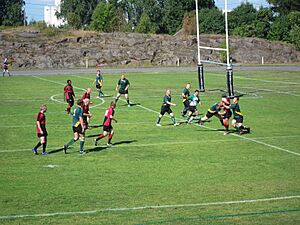
The local football team is KTP. Founded in 1927, KTP has long, and successful football history. KTP won the Finnish football championship in 1951 and 1952, and Finnish Cup 4 times, in years 1958, 1961, 1967, and 1980. Currently the club plays in the Finnish second league Ykkönen.
KTP-Basket plays in Korisliiga. There is also rugby club Griffins RFC.
Notable people
- Paavo Aaltonen (1919–1962), gymnast and Olympic champion
- Sari Baldauf (born 1955), businesswoman
- Jyri Häkämies (born 1961), politician
- Pentti Hämäläinen (1929–1984), boxer
- Juha Hirvi (born 1960), sport shooter
- Tapani Kansa (born 1949), singer
- Veikko Kokkola (1911–1974), politician
- Awak Kuier (born 2001), basketball player
- Rasmus Kupari (born 2000), ice hockey player
- Veikko Lavi (1912–1996), singer, songwriter and author
- Lasse Lehtinen (born 1947), politician
- Toivo Pekkanen (1902–1957), author
- Teemu Pukki (born 1990), professional footballer
- Jaana Saarinen (born 1955), actress
- Niilo Sevänen (born 1979), musician and director of culture in Kotka
- Taisto Sinisalo (1926–2002), communist politician
- Pentti Tiusanen (1949–2018), politician and surgeon
- Arto Tolsa (1945–1989), footballer
- Juha Vainio (1938–1990), lyricist, singer, composer and teacher
Twin towns — Sister cities
Kotka is twinned with:
|
See also
 In Spanish: Kotka para niños
In Spanish: Kotka para niños






